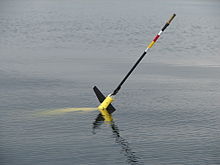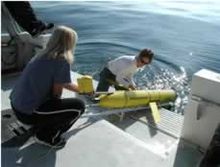Underwater glider
Underwater gliders are unmanned diving robots that use a principle similar to that of gliders to move . Since the drive, in contrast to the conventional propeller drive, requires almost no energy, underwater gliders can be used continuously for weeks or even years.
Working principle
By changing the density , the static buoyancy changes and the underwater glider rises to the surface of the water or sinks to the seabed. When it reaches the surface of the water, it increases in density and begins to sink. At a preset depth, it reduces its density and rises again to the surface of the sea. From this vertical movement, small wings generate a propulsion force for the forward movement, as in gliders . While conventional propulsion systems have a constant energy consumption for the propeller , underwater gliders only have to change the density at the transitions between ascent and descent. H. a short, energy-consuming change in density is followed by a long gliding passage without any expenditure of energy. The constant alternation between ascent and descent results in a sawtooth-like locomotion profile for underwater gliders .
The change in density usually takes place via hydraulic pumps that pump an oil supply back and forth between two flexible swim bladders , one outside and one inside the pressure hull . However, systems have already been tested that take advantage of the temperature stratification of the oceans. Paraffin , which solidifies in deep, cold ocean layers and melts again in upper, warm ocean layers , drives the immersion mechanism through the large change in volume during the phase transition . However, this method requires the greatest possible temperature gradient and can therefore only be used to a limited extent in the arctic zones.
It is controlled either by a hydrodynamic rudder or by shifting your weight . A magnetic compass , pressure sensor and an inertial platform are available for navigating underwater . These navigation results are corrected with the help of GPS every time you ascend to the water surface , since the GPS signals cannot be received underwater. The time on the surface is also used to transmit the data obtained during the diving process by radio (possibly via satellite ) to the control station. B. new waypoints . Special acoustic methods for navigation and communication have also been developed for use under the ice surface.
The achievable immersion depth depends only on the compressive strength of the components used. It varies from a few hundred meters up to 6000 m. Since no energy is required for the propulsion itself, but only for the change in density at the highest or lowest point, the main advantage of the underwater glider only comes into its own at greater depths. Use in shallow marginal seas such as the North or Baltic Sea therefore makes little sense. The achievable forward speed is rather low compared to conventionally powered underwater robots (up to about 1 km / h). The advantage arises rather from the long autonomous operating time, which significantly reduces the operating costs in the form of escort ships.
commitment
The main area of application for underwater gliders is oceanography . Equipped with sensors for water temperature, pressure, salinity and many other possible sensors, underwater gliders can cover large areas. Due to the high degree of autonomy and the comparatively low price, whole swarms of underwater gliders can be operated from a control station, which enables large-area long-term measurements with three-dimensional data acquisition. The Alfred Wegener Institute has already successfully used such underwater robots to survey the Fram Strait . The Leibniz Institute for Marine Sciences in Kiel also operates a whole swarm of these devices.
As part of a system test, the underwater glider RU-27 crossed the Atlantic from the US east coast to Spain for the first time (April 27 to December 4, 2009).
The special properties of underwater gliders also make them interesting for military applications. As part of the Persistent Littoral Undersea Surveillance Network (PLUSNet), the US Navy investigated the use of these gliders to locate enemy submarines .
See also
Web links
- Underwater Glider System Study , Scripps Institution of Oceanography
- Video of an underwater glider
- Video on the application scenario of an underwater glider
Individual evidence
- ↑ a b c Alfred Wegener Institute: Underwater glider. (PDF; 2.0 MB) (No longer available online.) Archived from the original on May 14, 2013 ; Retrieved February 11, 2013 . Info: The archive link was inserted automatically and has not yet been checked. Please check the original and archive link according to the instructions and then remove this notice.
- ↑ Scinexx: Robot diving boat crosses the Gulf Stream. Retrieved February 11, 2013 .
- ↑ European Patent Office: PHASE CHANGE MATERIAL THERMAL POWER GENERATOR. Retrieved February 11, 2013 .
- ↑ Wissenschaft Aktuell: Swims and measures and swims: Temperature-driven underwater glider passes test run. (No longer available online.) Formerly in the original ; Retrieved February 11, 2013 . ( Page no longer available , search in web archives ) Info: The link was automatically marked as defective. Please check the link according to the instructions and then remove this notice.
- ↑ Die Welt: US researchers develop submarines with thermal propulsion. Retrieved February 11, 2013 .
- ↑ Berliner Morgenpost: US researchers develop submarines with heat propulsion. Retrieved February 11, 2013 .
- ^ A b Wood, Stephen: Autonomous Underwater Gliders. (PDF; 4.0 MB) Retrieved February 11, 2013 .
- ↑ Spiegel online: diving glider: torpedoes for marine research. Retrieved February 11, 2013 .
- ^ Alfred Wegener Institute: ACOBAR - ACoustic Technology for OBserving the interior of the ARctic Ocean. (No longer available online.) Archived from the original on January 25, 2013 ; Retrieved February 11, 2013 . Info: The archive link was inserted automatically and has not yet been checked. Please check the original and archive link according to the instructions and then remove this notice.
- ↑ Leibniz Institute for Marine Sciences, Kiel: A swarm for research - IFM-GEOMAR uses new high-tech measuring robots for the first time in the association. Retrieved February 11, 2013 .
- ↑ Spiegel online: Science pictures January: Deep-sea gliders, fold dogs and an ice beauty. Retrieved February 11, 2013 .
- ↑ Washington Post: Submersible glider spent months collecting data on Atlantic waters. Retrieved February 11, 2013 .
- ↑ John A. Hildebrand, Gerald L. D'Spain: Glider-based Passive Acoustic Monitoring Techniques in the Southern California Region. (PDF; 296 kB) Accessed February 11, 2013 .



